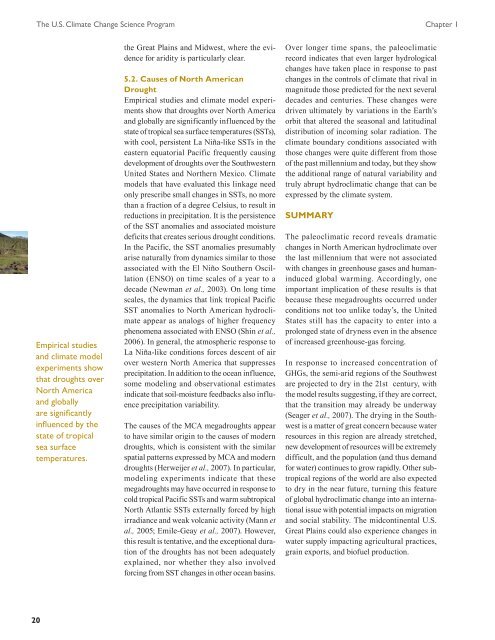Book 2.indb - US Climate Change Science Program
Book 2.indb - US Climate Change Science Program
Book 2.indb - US Climate Change Science Program
- No tags were found...
Create successful ePaper yourself
Turn your PDF publications into a flip-book with our unique Google optimized e-Paper software.
The U.S. <strong>Climate</strong> <strong>Change</strong> <strong>Science</strong> <strong>Program</strong> Chapter 1Empirical studiesand climate modelexperiments showthat droughts overNorth Americaand globallyare significantlyinfluenced by thestate of tropicalsea surfacetemperatures.the Great Plains and Midwest, where the evidencefor aridity is particularly clear.5.2. Causes of North AmericanDroughtEmpirical studies and climate model experimentsshow that droughts over North Americaand globally are significantly influenced by thestate of tropical sea surface temperatures (SSTs),with cool, persistent La Niña-like SSTs in theeastern equatorial Pacific frequently causingdevelopment of droughts over the SouthwesternUnited States and Northern Mexico. <strong>Climate</strong>models that have evaluated this linkage needonly prescribe small changes in SSTs, no morethan a fraction of a degree Celsius, to result inreductions in precipitation. It is the persistenceof the SST anomalies and associated moisturedeficits that creates serious drought conditions.In the Pacific, the SST anomalies presumablyarise naturally from dynamics similar to thoseassociated with the El Niño Southern Oscillation(ENSO) on time scales of a year to adecade (Newman et al., 2003). On long timescales, the dynamics that link tropical PacificSST anomalies to North American hydroclimateappear as analogs of higher frequencyphenomena associated with ENSO (Shin et al.,2006). In general, the atmospheric response toLa Niña-like conditions forces descent of airover western North America that suppressesprecipitation. In addition to the ocean influence,some modeling and observational estimatesindicate that soil-moisture feedbacks also influenceprecipitation variability.The causes of the MCA megadroughts appearto have similar origin to the causes of moderndroughts, which is consistent with the similarspatial patterns expressed by MCA and moderndroughts (Herweijer et al., 2007). In particular,modeling experiments indicate that thesemegadroughts may have occurred in response tocold tropical Pacific SSTs and warm subtropicalNorth Atlantic SSTs externally forced by highirradiance and weak volcanic activity (Mann etal., 2005; Emile-Geay et al., 2007). However,this result is tentative, and the exceptional durationof the droughts has not been adequatelyexplained, nor whether they also involvedforcing from SST changes in other ocean basins.Over longer time spans, the paleoclimaticrecord indicates that even larger hydrologicalchanges have taken place in response to pastchanges in the controls of climate that rival inmagnitude those predicted for the next severaldecades and centuries. These changes weredriven ultimately by variations in the Earth’sorbit that altered the seasonal and latitudinaldistribution of incoming solar radiation. Theclimate boundary conditions associated withthose changes were quite different from thoseof the past millennium and today, but they showthe additional range of natural variability andtruly abrupt hydroclimatic change that can beexpressed by the climate system.SummaryThe paleoclimatic record reveals dramaticchanges in North American hydroclimate overthe last millennium that were not associatedwith changes in greenhouse gases and humaninducedglobal warming. Accordingly, oneimportant implication of these results is thatbecause these megadroughts occurred underconditions not too unlike today’s, the UnitedStates still has the capacity to enter into aprolonged state of dryness even in the absenceof increased greenhouse-gas forcing.In response to increased concentration ofGHGs, the semi-arid regions of the Southwestare projected to dry in the 21st century, withthe model results suggesting, if they are correct,that the transition may already be underway(Seager et al., 2007). The drying in the Southwestis a matter of great concern because waterresources in this region are already stretched,new development of resources will be extremelydifficult, and the population (and thus demandfor water) continues to grow rapidly. Other subtropicalregions of the world are also expectedto dry in the near future, turning this featureof global hydroclimatic change into an internationalissue with potential impacts on migrationand social stability. The midcontinental U.S.Great Plains could also experience changes inwater supply impacting agricultural practices,grain exports, and biofuel production.20






